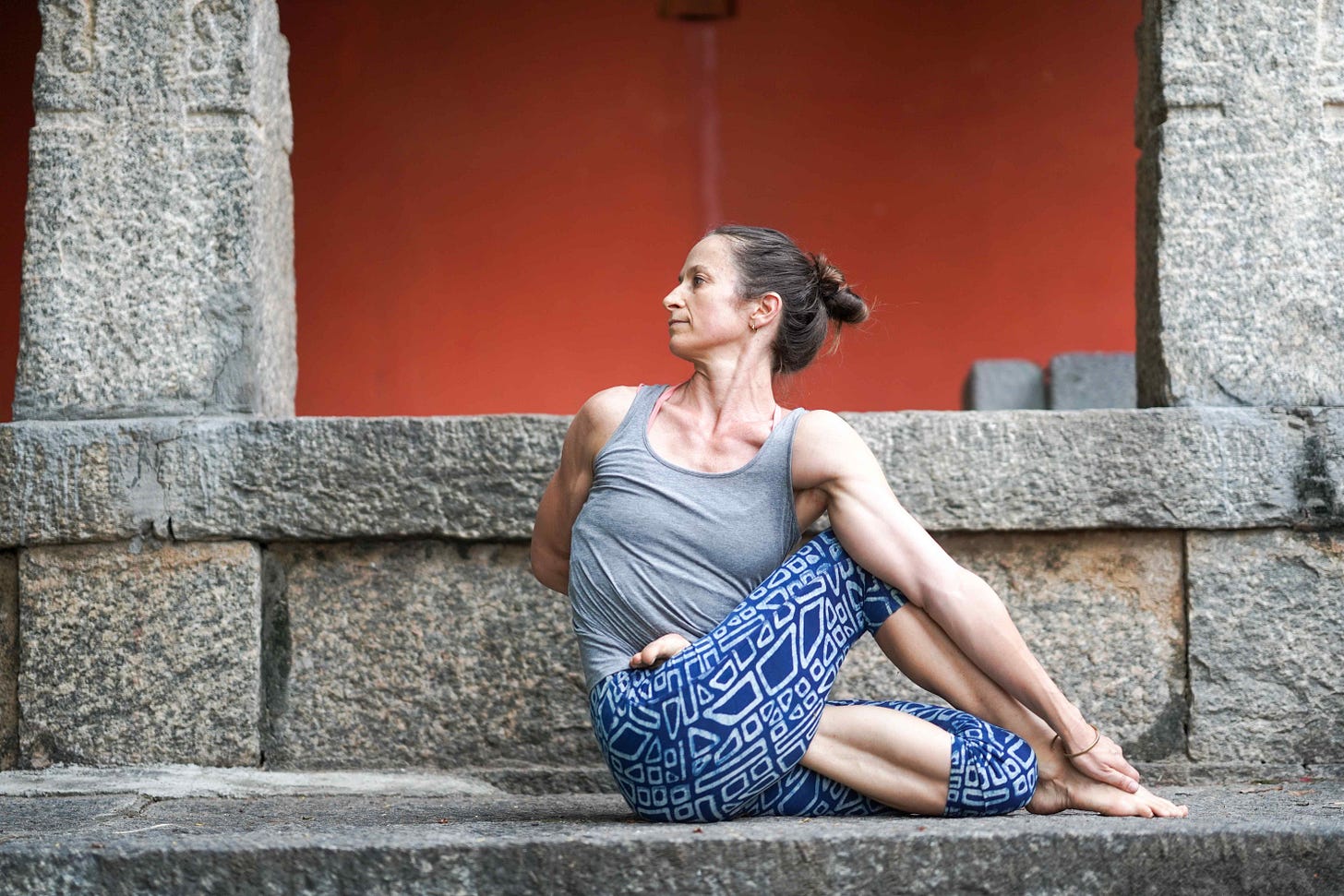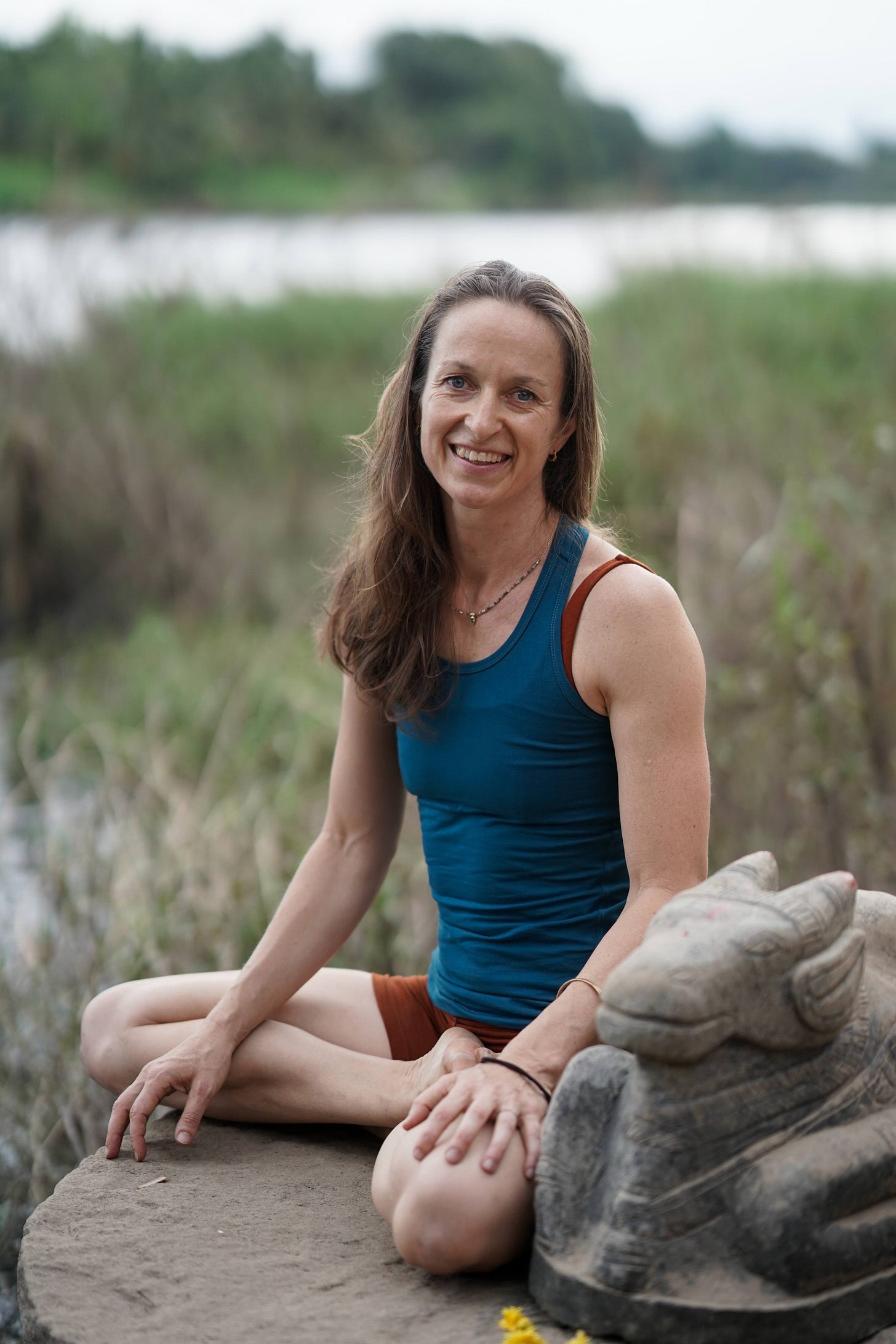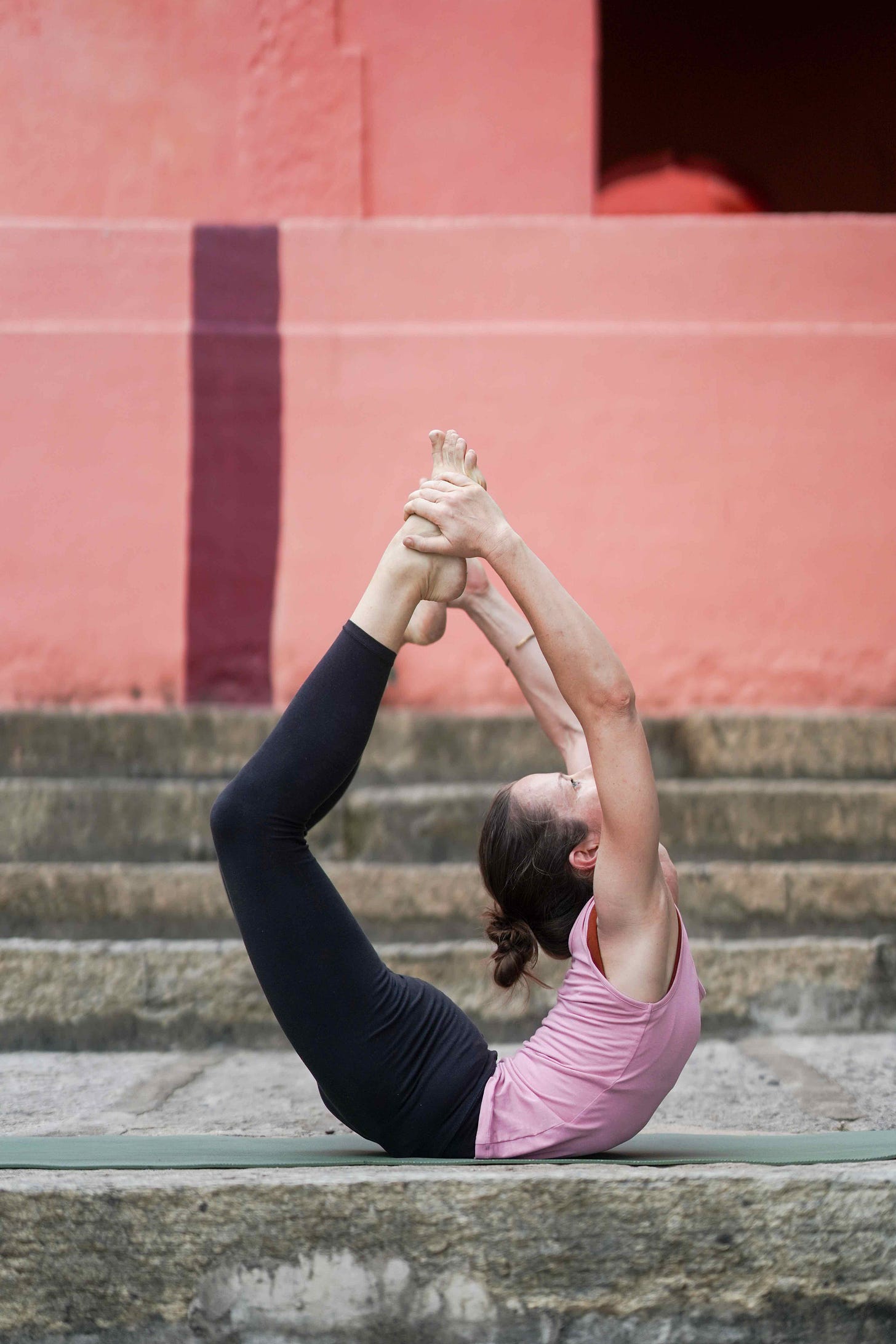Ashtanga Post Lineage - Ash Hope
A long-form interview series with advanced practitioners and senior teachers on the future of the Ashtanga Vinyasa lineage
Can you share your background before yoga — both personally and spiritually?
I grew up in East Germany and witnessed firsthand the profound challenges of uniting two seemingly opposing forces, an experience that deeply resonates with the yogic path of finding harmony between dualities. I intuitively knew there was something greater to connect to, but I didn’t have access to spiritual guidance.
My life was filled with studying, working and partying.
What initially drew you to yoga, and to Ashtanga specifically?
It was a cold winter evening in Germany when I walked into my first Bikram yoga class. Until then I'd never heard of yoga and was purely there to warm up and find some relief for my back pain. The profound moment of this experience was during the breathing exercises in the beginning of the class. It felt like I was breathing for the very first time.
It took me a few more years of practicing Bikram and other yoga types until I traveled to India to learn from the source. My first Ashtanga class was nothing like I’d ever experienced before. It was intense and challenging but there I was in India, committed to learn, and so I did. After a few weeks, I learnt the half primary series, my body adjusted, and I was also introduced to meditation, pranayama, chanting and yoga philosophy.
Was there a particular moment when you felt: “This is my path”?
The more I learnt about yoga, the more I learnt about myself. Ashtanga opened an internal door that I never knew existed. It felt so natural to dive deeper into the practice.
How did your body and mind respond in those early months or years?
I am not naturally flexible or strong and also didn’t have a background as a dancer or gymnast. The practice challenged me physically, my body was stiff and sore. But I was drawn to practice every day. I enjoyed the movement, the connection with my breath and how I felt during and after my practice.
Who were your first Ashtanga teachers? What impact did they have?
My early exploration of Ashtanga Yoga was influenced by Andrea Lutz in Berlin. She was a student of both Nancy Gilgoff and Manju Jois and for a couple of years I practiced at her studio in Berlin. It was through Andrea's connection that I had the fortunate opportunity to meet Manju and Nancy, who subsequently became my primary teachers and have shaped my practice ever since.
How did you relate to the idea of lineage when you first began?
Nancy Gilgoff was my primary teacher and direct link to the lineage of Pattabhi Jois. She had a long history of studying directly with Pattabhi Jois, assisting him and sharing her depth of knowledge in a very unique way. She understood the inner workings of the practice — how to direct the internal flow of energy to heal and strengthen the body and mind. Her healing hands always had a magic touch.
Although I had the opportunity to practice with Sharath in Mysore, my relationship with Nancy had already been well established, and I felt deeply connected to the practice and its lineage through her teachings. Nancy taught how she was taught by Pattabhi Jois. She was one of the few that did not make any changes to the system she received back in the 1970s.
This “old school” Ashtanga was taught as a system to liberate and empower students and not as a tool to control and to create dependency. The old way of teaching enables a student to build a deep relationship within themselves, to understand the workings of this system and how it can be best applied throughout different stages of life.
Eventually, after completing the Primary, Intermediate and Advanced A+B series, the students graduate to the Rishi series, where the student practices 10 asanas and holds them for 50 breaths. By then, the student is ready to understand the energetic aspects of the practice and selects the asanas appropriate for that day.
Was there a sense of devotion, doubt, or something in between?
I have always had full faith in the practice and trust in my teachers. Without that trust, how could any real learning or growth happen? Over time it grew into devotion, not in a religious but in a spiritual sense.
What kind of relationship — personal or pedagogical — did you have with your main lineage connection?
Nancy was my teacher but also a friend. She taught me much about yoga and even more about life. Over the years, we met in different countries around the world, and I always admired her generosity in sharing her knowledge and her deep love for the practice. I especially cherished visiting her on Maui, where she lived and taught. Staying at her home with her holds special memories. In 2018, Nancy and her daughter Vanessa came to visit us in Australia — her first and only time teaching in this part of the world. It was an honour to host her. Being by her side just before she passed away was special in a very different way. Until the end she was optimistic to travel and teach again — she had so much love for the practice and her students.
I’ve learned so much from her, and I do my best to honour her legacy in my own practice, teaching and life.
Did that relationship evolve over time? If so, how?
The relationship evolved over time but sadly ended too soon. Nancy is still guiding me in my practice, teaching and life and I still catch myself discovering new insights that she shared with me in the past.
How has your practice evolved over the years — physically, emotionally, and spiritually?
My first trip to India and introduction to the eight limbs of yoga gave me insight into yoga as a holistic system. I felt right at home in my asana practice and enjoyed the gradual progression of the sequence. Over the years, I explored different types of meditation and joined a Buddhist meditation group for a couple of years. However, I didn’t truly connect with my meditation practice until I attended a week-long meditation retreat. It was the practice of zazen that finally captivated me and gave me clarity in my meditation practice.
I was first introduced to Vedic chanting by Manju Jois and attended classes with Dr M.A. Jayashree throughout the years. In 2022 I began studying with Shantala from Vedic Studies and it has opened a new dimension to the ancient practice of Vedic chanting. The practice requires immense concentration and has a deeply spiritual aspect.
For my daily sadhana I prioritize my asana and pranayama practice and try to be as consistent as possible with my chanting and meditation practice.
I start each day by reading books and journaling — a practice that offers both insight and space for contemplation.
What kept you practicing through major life changes (parenthood, injury, career, etc.)?
It was my practice that got me through life changes.
The first few years of my practice I was going through an emotional rollercoaster. Not because of the practice but because of my life. It was a mess and I felt lost in many ways. Getting on my mat felt safe and my practice became my refuge. The practice gave me stability, a place to find peace, time to breathe, connect with my body, and forget about my life as it was at that time.
Eventually, I found my feet again and I was keen to learn and grow, especially in my yoga practice. I put all my resources towards traveling the world so I can study with the most senior teachers of the Ashtanga lineage. I have always felt that my practice was a supporting force in my life. It gave me strength, courage, and energy to show up in life and to find my way.
Have there been moments when you nearly stepped away from the practice entirely?
Nope
What have been your biggest learnings through difficulty?
Just breathe and take it one by one.
How does the practice manifest off the mat for you today?
There is not much separation between on and off the mat or cushion. The different practices I do throughout the day provide a consistent baseline for my thoughts and actions. When I am not on the mat / cushion, I still contemplate the practice, especially when I teach, write or read. It provides a focus point I can continually come back to when my mind wants to pull me into negative thoughts.
What does “daily practice” mean to you now?
Daily practice means to have a spiritual connection with oneself. And to have the tools and capacity to cultivate and deepen this connection. I do believe though, that the foundation for spiritual growth needs a healthy body and mind and therefore asana practice can support this. My practice is not a task or something I have to do, it is a way of being and living in harmony with my body, mind and spirit.
How do you balance tradition with adaptation in your own practice?
The practice provides a roadmap. There will be obstacles along the way — times when we feel stuck or challenged physically and mentally. Encountering these challenges is both important and necessary. If we divert onto a different path that seems more appealing (perhaps a shortcut?) or turn away from these challenges, we might miss the opportunity to overcome our limited mind.
Life becomes more intentional when we live in accordance with ethical guidelines (yamas and niyamas — the first two limbs of the eight limbs of Ashtanga Yoga), which help us navigate through the confusion and delusion. Not to waste our energy, time and resources but to use them for personal growth, spiritual advancement and the greater good of all.
What does it mean to teach Ashtanga in a post-lineage era?
When the student is ready the teacher will (dis)appear. The lineage comes to live through the teachings. It can be found on the yoga mat of every sincere student. Now, as before the passing of Nancy and Sharath, it is in our hands to uphold and continue the lineage. As a teacher and in honour of my teacher, I see it as my responsibility, to pass on the knowledge and wisdom that was passed down to me from my teacher.
Has your teaching changed in the wake of Sharath’s death?
No it has not changed.
What do you believe students need most from teachers now?
Students need teachers with an in-depth understanding of Ashtanga Yoga as a system and not just performers / gatekeepers of asanas. The central question for the teacher needs to be: “How does the practice apply to the individual student?” Considering lifestyle, age, abilities etc. And how to adjust the practice so it becomes a life supporting tool, especially in times of illness and aging.
How has your relationship to the Mysore community shifted in recent years?
Although I have spent time in Mysore, I don’t consider myself as a close member of the Mysore community. I see myself as part of the global Ashtanga community — aligned with those who, like me, studied with the Ashtanga teachers from the “old school” (Nancy Gilgoff, Manju Jois, David Swenson, etc.)
Do you see a post-lineage model emerging — or something else entirely?
A lot of teachers adapt / change their way of teaching, yet still call it Ashtanga yoga. This leads to confusion and dilution of the Ashtanga lineage. I think this trend will continue and become more pronounced now that the central figure of the lineage has passed.
Where do you feel the energy of the practice is migrating?
Energy flows where attention goes.
Depending on one’s perspective, this moment in time can either hold the greatest potential or mark the end of an era. But isn’t it the essence of the teachings, to be comfortable with diversity, to overcome challenges, be calm in the storm and fight the fight of the righteous? It is up to us as individuals and the collective to bring our practice into action.
Is there a community you feel aligned with today?
I feel most connected with the people who I met along the way over the years of studying with Nancy. I also feel very connected to our community in our yoga shala in Brisbane. It is wonderful to have a space for our local students to practice and we always love when traveling practitioners visit our shala.
What role does spirituality or inner inquiry play in your practice today?
It is one of the most important aspects of my practice and one of the reasons why I practice. Most of the time I practice on my own, which removes the dependency / distraction of a physical teacher and also the reliance on other people’s energy to sustain my practice. Over the years it has helped me to connect deeply on a spiritual level, allowing me to move beyond the physical and connect to something greater than myself.
Has your understanding of yoga philosophy changed over time?
I have come to understand and appreciate the difference between Western and Eastern Philosophy. Eastern Philosophy is often woven into stories and riddles, meant to be unpacked gradually through sustained practice. It is not intended to be grasped purely on an intellectual level; rather, its true meaning and application unfold naturally over time.
Has your relationship to faith or the sacred deepened or shifted?
I have always felt a pull towards the spiritual without understanding what that was. The church as an institution did not appeal to me and god was a concept I could not grasp. Studying the philosophical aspects of yoga has helped me to connect with my spirituality, it has shown me the way to see God in everything.
What do you think is ending with Sharath’s passing?
Sharath’s passing is a great loss for his family, friends, the community in Mysore and for the greater Ashtanga community. Sharath was the central figure of this lineage — serving both as a guiding reference for the teachings and creating a space to come together to share this practice.
What do you think is being born?
There is an opportunity to reflect on and reform the tradition of Ashtanga Yoga. I think it puts a greater responsibility on the teachers of Ashtanga yoga to lead through this period of change. At some point the student has to detach from the teacher, it is a natural progression.
Are you hopeful or uncertain about the future of Ashtanga?
I am hopeful and optimistic about the future of Ashtanga. Those who are sincere in their practice and teaching, will continue on their path and reap the benefits. Those who came for the hype will fade away, and that’s ok too.
What role do you see for yourself in this unfolding?
I am dedicated to sharing the teachings of Ashtanga yoga in the “old school way” as I was taught by Nancy Gilgoff.
What would you say to a student starting the practice now, without a central teacher?
I believe it is essential—especially in the early years—to learn from an experienced teacher, or at the very least, to have a clear point of reference to provide guidance. With the vast amount of (mis-)information available today, new students can easily become misguided, confused, or even discouraged from engaging with the practice.
Do you think Ashtanga still has something unique to offer at this moment in history?
Ashtanga is a powerful method for healing and personal transformation. It is needed now more than ever, and many people can benefit from this practice.
Is there anything you’ve never had the chance to say about your journey?
When Krishnamacharya left his guru in the Himalayas after seven years of study, he was sent out to live the life of a householder and to teach yoga. At that time, I don't believe he saw himself as a lineage holder. He was a teacher of yoga, with the intention of making the practice accessible to everyday people.
Krishnamacharya’s teachings gave rise to several great yoga teachers, each of whom refined and developed their own systems of yoga. Among them was Pattabhi Jois, who followed in Krishnamacharya’s footsteps and developed the Ashtanga sequence as we practice it today. Many of Pattabhi Jois’s students went on to teach and developed their own approaches as well.
Change is ever-present. The passing of Sharath does not mark the end of Ashtanga Yoga. As students, teachers, and members of this global community, we are called to rise above our fear of uncertainty and loss, and to meet this new era with courage and clarity. The teachings of the lineage have been passed on to us from our teachers so we can pass them on to the next generation. It means to walk the dharmic path, through living ethically, teach with integrity and to be aligned with something greater than ourselves.
Ash Hope is teaching a retreat in Italy in September, here is the link https://www.ashtangayogacentre.com.au/retreatitaly/
And see her website for more info : https://www.ashtangayogacentre.com.au/classes/ All classes are online on zoom and in her shala.









